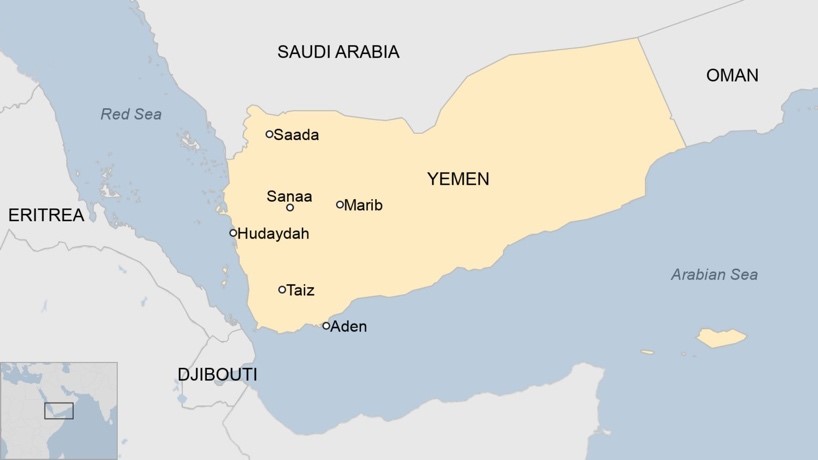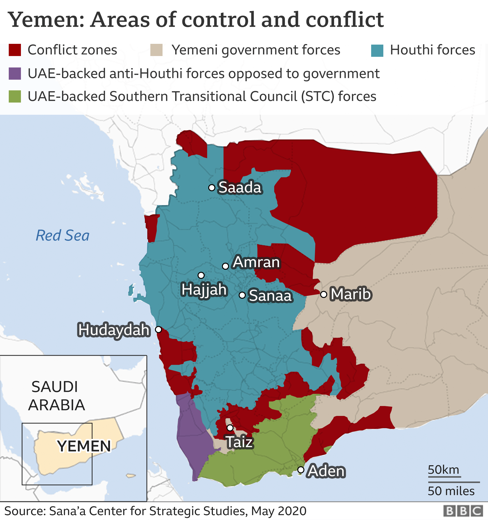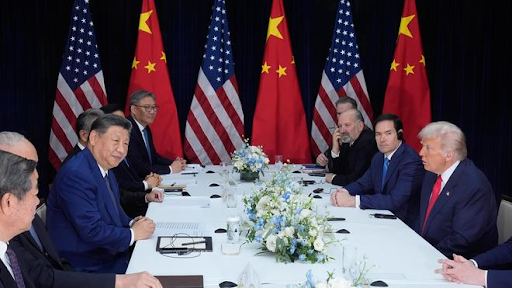Description

Disclaimer: Copyright infringement not intended.
Context
- Hundreds of prisoners captured during the war in Yemen were reunited with their families.
- The main warring sides in Yemen are the Iran-backed Houthis and the pro-Yemen government, Saudi-led coalition.
Details
- The large-scale prisoner swap has given the people hope for a permanent ceasefire in Yemen.
What is the Stockholm Agreement?
- The warring parties in control of parts of Yemen had signed the Stockholm Agreement in December 2018 whereby they had committed to freeing conflict-related detainees.
- The agreement brokered by the United Nations had three main components — the Hudayah agreement, the prisoner exchange agreement, and the Taïz agreement.
- The Hudayah agreement included a ceasefire in the city of Hodeidah and other clauses like no military reinforcements in the city and strengthened UN presence.
- The Taïz agreement includes the formation of a joint committee with participation from civil society and the UN.

The war
How did the war start?
- In 2011, a popular uprising in Yemen forced its long-standing authoritarian president, Ali Abdullah Saleh, to hand over power to his deputy, Abdrabbuh Mansour Hadi.
- However, the new president was overwhelmed with Yemen's economic problems, and security problems such as attacks by jihadists.
- Furthermore, most of Yemen's armed forces felt more loyalty to the ousted president than they did to Mr Hadi.
- The Houthis took advantage of his weakness.
- Formally known as the Ansar Allah (Partisans of God), they champion Yemen's Zaidi Shia Muslim minority.
- In early 2014, they seized control of Saada province, in the north of the country and then captured the nation's capital, Sanaa, forcing President Hadi to flee abroad in March 2015.
- A Saudi-led multinational coalition intervened in the conflict in Yemen in March 2015
- Yemen's neighbour Saudi Arabia was alarmed by the prospect of the Houthis taking control of Yemen, fearing it would become a satellite of Saudi Arabia's rival, Iran.
- In March 2015, it and other Arab states began an air campaign aimed at ousting the Houthis and restoring Mr Hadi's government.
- The coalition received logistical and intelligence support from the US, UK and France.

What's happened since then?
- In August 2015, coalition ground troops landed in the port city of Aden and drove the Houthis out of the south of Yemen. However, they could not dislodge them from Sanaa or the north of the country.
- Yemen's official government is now in Aden, while President Hadi himself is based in Saudi Arabia.
- The Houthis allied with the former president, Ali Abdullah Saleh, to form a "political council" to govern the area under their control.
- However, in December 2017, Saleh broke with the Houthis and called for his followers to fight them. Saleh was killed and the Houthis defeated his forces.
- In 2018, the Saleh loyalists joined the Saudi-led coalition. Together, they launched a major offensive against the Houthis to recapture the Red Sea city of Hudaydah. The port there is the principal lifeline for millions of Yemenis at risk of famine.
- The Houthis have attacked targets in Saudi Arabia and the UAE with ballistic missiles and drones, targeting sites including oil installations but also injuring civilians.
- Saudi and US officials have accused Iran of smuggling weapons such as drones to the Houthis, in violation of a UN arms embargo. Iran has denied the allegation.
- The UN says both sides in the civil war may have committed war crimes. Both sides deny the allegation.
- In April 2022, the UN brokered a ceasefire between the Saudi-led coalition and the Houthi rebels, though the sides failed to renew it six months later.
- However they recently agreed to swap prisoners as a confidence measure which it is hoped could lead to a permanent ceasefire.

What's been the human cost?
- The UN says Yemen is experiencing the world's worst humanitarian crisis.
- It says 5 million people, one in seven of the population, have been displaced. while 24.1 million people, 80% of the population, are in need of humanitarian aid and protection.
- More than 10,000 children have been killed in the fighting, according to the UN
- The UN estimated that by the start of 2022, the conflict in Yemen had caused over 377,000 deaths, with 60% the result of hunger, lack of healthcare and unsafe water.
What are Yemen’s divisions?
- Yemen has long struggled with religious and cultural differences between its north and south and the legacy of European colonialism.
- The modern Yemeni state was formed in 1990 with the unification of the U.S.- and Saudi-backed Yemeni Arab Republic, in the north, and the Soviet-backed People’s Democratic Republic of Yemen, in the south.
- Ali Abdullah Saleh, a military officer who had ruled North Yemen since 1978, assumed leadership of the new country.
- However, just four years after unification, southern separatists seceded for several months and reemerged in 2007 as the Southern Movement, which has continued to press for greater autonomy within Yemen.
- Al-Qaeda in the Arabian Peninsula (AQAP), an Islamist militant group, and the related Ansar al-Sharia insurgent group have captured territory in the south and east
- The Houthi movement, whose base is among the Zaydi Shiites of northern Yemen, rose up against Saleh’s government six times between 2004 and 2010.
What caused the current crisis?
- Several factors widened these political divisions and led to full-scale military conflict.
Fuel price hikes
- Under pressure from the International Monetary Fund, which had extended to Yemen a $550 million loan premised on promises of economic reforms, Hadi’s government lifted fuel subsidies in 2014.
- The Houthi movement organized mass protests demanding lower fuel prices and a new government.
Houthi takeover
- The Houthis captured much of Sanaa by late 2014.
- Hadi’s government resigned under pressure in January 2015 and Hadi later fled to Saudi Arabia.
Military division
- Military units loyal to Saleh aligned themselves with the Houthis, contributing to their battlefield success.
- Other militias mobilized against the Houthi-Saleh forces, aligning with those in the military who had remained loyal to the Hadi government.
- Southern separatists ramped up their calls for secession.
Saudi intervention
- In 2015, with Hadi in exile, Riyadh launched a military campaign—primarily fought from the air—to roll back the Houthis and restore the Hadi administration to Sanaa.

What are the prospects for a solution to the crisis?
- UN-backed peace negotiations have made limited progress.
- The 2018 Stockholm Agreement averted a battle in the port city of Hodeidah, a vital hub for aid; but there has been little success in implementing the accord’s provisions, which includes the exchange of more than fifteen thousand prisoners and the creation of a joint committee to de-escalate violence in the city of Taiz.
- Observers worry that friction among regional actors, including Iran, Saudi Arabia, and the UAE, is prolonging the war.
About Yemen
- Yemen, officially the Republic of Yemen, is a country in Western Asia.
- It is situated on the southern end of the Arabian Peninsula, and borders Saudi Arabia to the north and Oman to the northeast and shares maritime borders with Eritrea, Djibouti and Somalia.
- Yemen is the second-largest Arab sovereign state in the Arabian Peninsula.
- Its constitutionally stated capital, and largest city, is Sanaa.
- In ancient times, Yemen was the home of the Sabaeans, a trading state that included parts of modern-day Ethiopia and Eritrea.
- Yemen is a member of the Arab League, the United Nations, the Non-Aligned Movement and the Organisation of Islamic Cooperation.
- It belongs to the least developed country group.
- As of 2020, the country is placed the highest in the Fragile State Index, the second worst in the Global Hunger Index, surpassed only by the Central African Republic, and has the lowest Human Development Index out of all non-African countries.
|
PRACTICE QUESTION
Q) UN-backed peace negotiations have made limited progress in Yemen. Discuss the role of UNHCR in this regard. (150 words)
|

https://epaper.thehindu.com/ccidist-ws/th/th_delhi/issues/33047/OPS/GA1B4L6PL.1.png?cropFromPage=true











